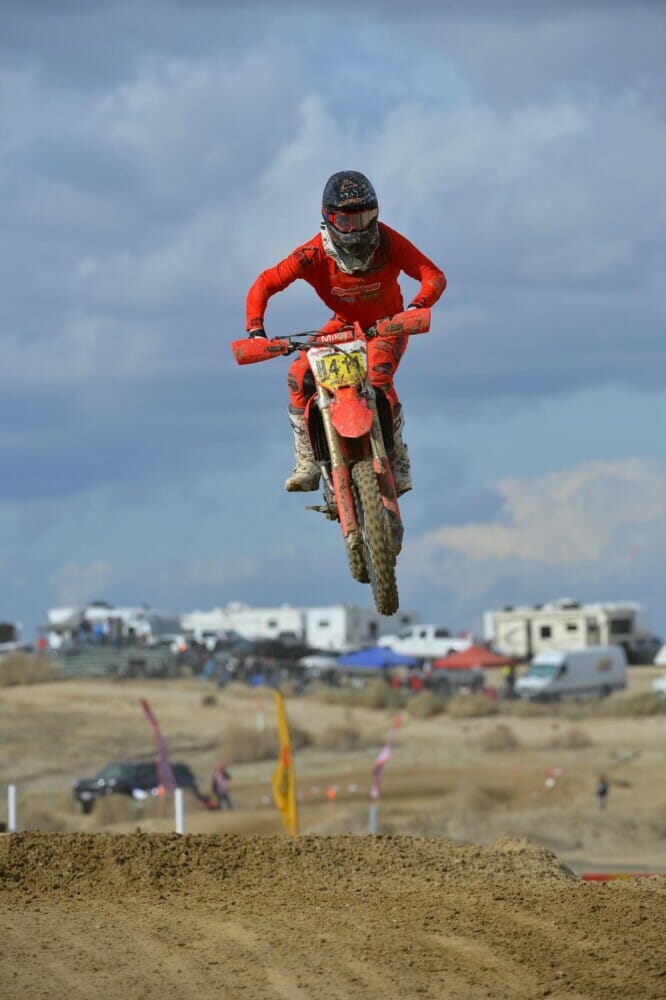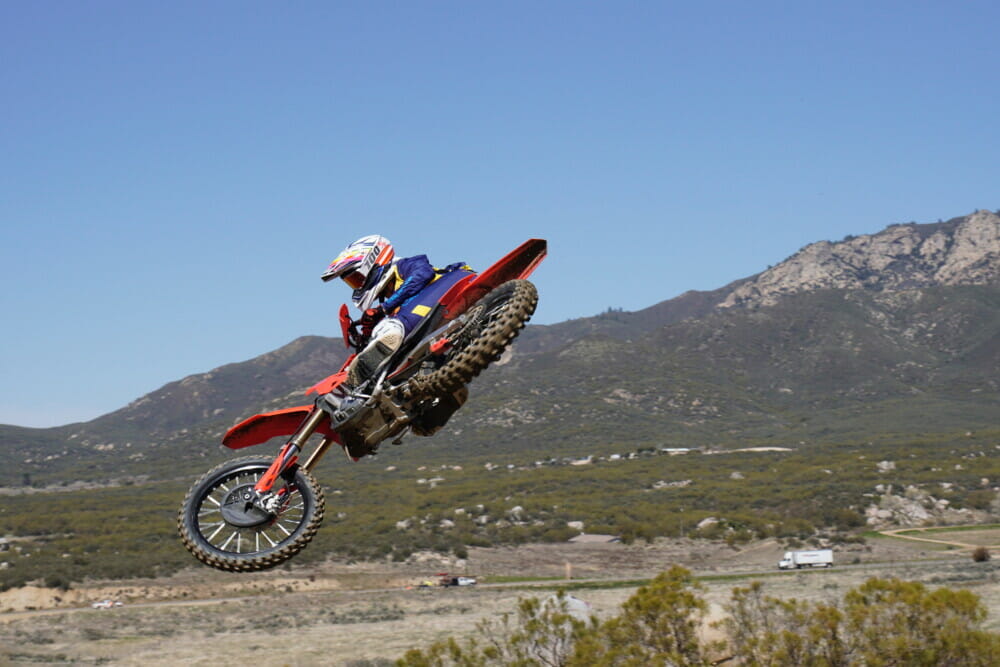| June 24, 2021
We check back with Honda’s new CRF450R.
 The 2021 Honda CRF450R came with some kinks that need to be ironed out.
The 2021 Honda CRF450R came with some kinks that need to be ironed out.
By Ryan Nitzen
The 2021 Honda CRF450R was by far the most anticipated bike of the new model year, and understandably so. Honda’s flagship model was one of the first ’21 models to be unveiled, and leaked spy photos had riders drooling over its all-new look. The bike was also announced during peak coronavirus lockdowns, and bikes were nearly impossible to get at the time. With demand at a near all-time high, Tim Gajser raced this bike to an MXGP World title before it ever touched a stateside dealership floor. The hype was certainly real, and we were eager to throw our leg over the bike at the model introduction back in September.
We were relatively pleased with the bike during our first ride test. The Red Ride shaved off seven pounds from the previous generation CRF, and the chassis felt much more predictable. A few issues like the ECU “gurgle” and the softer suspension were noted on day one but didn’t fully come to light until our 450 Shootout later. And while it topped the votes as the best-looking bike and was also the lightest of the Japanese models, CRF didn’t rank as high as we thought it would, finishing in the back of the pack. Honda admitted that due to the pandemic, final factory settings probably weren’t as dialed as they could’ve been, and the results of this were revealed on the track going heads up against its class rivals.
 Updating the ’21’s ECU does wonders for the Honda.
Updating the ’21’s ECU does wonders for the Honda.
A few months later and more than 25 hours of ride time on the CRF’s hour meter later, we’ve learned a few things about the new CRF450R.
First, let’s address the ECU. The Honda crew flashed our ECU with settings that the bike should’ve had in the first place. The new settings eliminate that dreaded gurgle that made it feel like a dirty carburetor with a hesitant bog in high gears at low rpm’s. Trying to roll on the gas through a sweeping rut? Nope. Popping out of a deep turn and trying to use the power to pull you out? Think again. There was a night and day difference in the motor once this issue was resolved. The overall engine character became much more predictable, and the power rolled on like it was supposed to. If your bike has the gurgle, no problem, your Honda dealer will be happy to dial it in for you, just like ours.
So, what was our favorite map with the new ECU? Map, two; traction control, one. I prefer mellowing out 450s these days and often choose to run them in the “slower” map option for added confidence and the ability to ride the bike more towards its potential. The different maps really do offer a lot of variety, and while three maps, three modes of traction control, and launch control are a lot to work with, there is always a good setup for any type of rider or track condition to be had.
 The Honda already feels light and agile out of the crate.
The Honda already feels light and agile out of the crate.
In the suspension department, the Honda techs dialed our bike in, literally. I loved the firm feeling of the CRF450R Works Edition (WE) model, and while that bike comes with Kashima Coated everything, the guys were still able to help us find a similar feeling with the standard model. Stiffening the fork 2-3 clicks allowed it to hold up better upon entry under braking and reduced its willingness to dive through the initial part of the stroke. The bike worked well for our liking with the standard shock settings and the typical 105mm sag, so we placed more of the setup focus on the forks. I have become somewhat accustomed to the “spongy” feeling of the CRF components and found comfort in the bike’s ability to stick through the entirety of a long rut. After the initial lean-in, the Honda will practically do the turning for you.
What did we add? Well, after riding the CRF450RWE, we wanted some extra grunt to accompany the newly flashed ECU. At this point, the standard exhaust system had become loud and blown out, so we figured we’d kill two birds with one stone. The crew at Yoshimura offered us its RS-12 Full Exhaust System, and we quickly mounted it up. This reminded us how much we love the simplicity of a single-sided exhaust system which Honda went back to this year. The Yosh dropped 1.3 pounds on the scales and added a much crisper response in all areas of the rpm’s. So much so that it even coaxed us into switching over from map two to the more potent map one. The exhaust smoothed out the power curve and made the bike even more fun to ride. In addition, it made us realize how loud the stock unit had become! The Yoshimura system is much quieter, especially from the saddle. Plus, it’s hard to not love the look of that factory titanium carbon combo.
 Going to an aftermarket exhaust system like this Yoshimura RS-12 unit is a good way to save some weight.
Going to an aftermarket exhaust system like this Yoshimura RS-12 unit is a good way to save some weight.
The rider cockpit also got switched up, not out of necessity, but in the name of personalization. Bars, grips, and levers were all exchanged for aftermarket components. Mika Metals handled the bars and grips, opting for their oversized Raw Series Bars in the STV bend. The stock grips are brutally tough, so we swapped those out for a softer set of 50/50 waffle grips. ASV also contributed a pair of their adjustable F4 Levers to eliminate the chance of a busted lever.
We’ve also tallied up some wearable parts during our stay with the CRF. A set of tires, an air filter, brake pads, sprockets, a chain, and countless oil filters completed our list of necessities. The folks at Sunstar helped, too, by getting us geared up with new hardware for the drivetrain department.
To make living with the new CRF450R easier, Honda switched over all the plastics bolts to 8mm heads. This makes pulling off the plastic and seat much simpler. No more fiddling with the eights for the plastic, the 10s for the seat, and the 12s for who knows what. Just grab the eight-mil T-handle, and you’re good to go.
Another notable is the electric start clutch safety switch has been eliminated. You can now start the bike without pulling in the clutch beforehand.
Lastly, the seat bolts have been moved to the center of the seat, and the seat assembly slides on in reverse from previous Honda generations. It’s a smoother system to work with.
The sight glass on the engine case is another hit. We’ve been through quite a few oil filters on this bike, and having the sight glass with lines for the suggested oil level adds an extra level of reassurance during an oil change. Thankfully, the bike continues to only have one oil fill compartment and one drain plug, continuing that design from the 2017-’20 engine layout.
The airbox is all-new for 2021, and the air filter itself now locks in upside down. This design looks foreign at first, but because of this, Honda was able to increase its air capacity. Getting to the filter no longer requires taking off the seat. Instead, it’s hidden behind the number plate like KTM and Kawasaki. The cage can be a bit of a hassle with its numerous tabs, but removing and installing the air filter feels much easier than it did with the previous generations.
We rode this bike at numerous track days, from Cahuilla Creek to State Fair, and even lined up for the Taft round of the NGPC Series on this bike, adding nothing but a set of Polisport hand guards. The bike helped us take home second-place finishes in the 450B and 25+ B categories, but some of its flaws showed through on the rough square-edged course.
 Our ’21 CRF450R has already garnered a few trophies in the NGPC Series. Photo: Mark Kariya
Our ’21 CRF450R has already garnered a few trophies in the NGPC Series. Photo: Mark Kariya
The soft suspension did help absorb some of the chatter bumps, but the harsh valving wanted to kick in the bigger holes. Not the end of the world; just pick better lines and avoid the bumps, right? The front end also had its moments of twitchiness, especially in the high-speed sections. This unwanted headshake most likely could’ve been solved by dropping the forks down in the clamps or by adding a stabilizer. In the end, though, it worked well enough for our fair-weather off-road racer, and we were pleased with the podium results.
The 2021 CRF450R may go down in the history books as one of those “be careful of a first model-year” lessons. It’s a solid platform that just needed a little extra push to get it to the finish. Unfortunately, that’s not what you want to hear when you walk out of the dealership with a new bike.
After working out the kinks, it has really lived up to its own hype. It possesses a strong motor package that is fast like the ’19 and ’20 models but now has a new smooth taste to carry you through the rpm range. The engine also has more maps than ever to help riders find the perfect setting. The “razor-like cornering” was another talking point at the model intro, and with some suspension tuning, it really can slice through sections with ease. The lighter chassis aids in this as well, and the bike doesn’t pitch front to back like the older generation.
With 2022’s right around the corner, we are hopeful that the second model year Honda will learn its lesson and the CRF450R will leave the factory with all the bugs worked out from the ’21. There are plenty of positives to take away from this new-gen machine, but we’re optimistic that the best is still yet to come from Big Red. CN